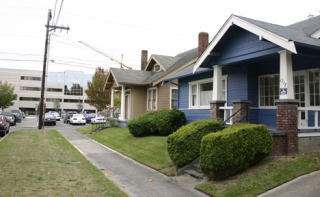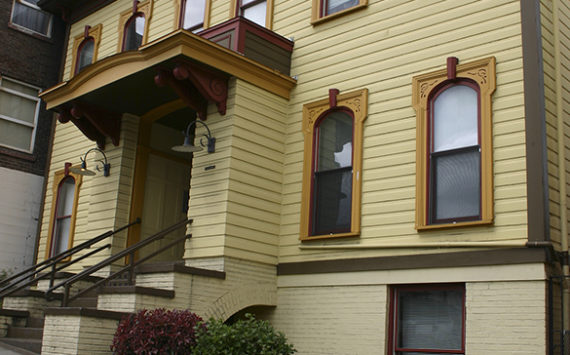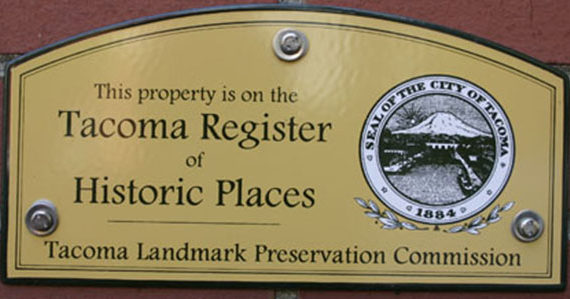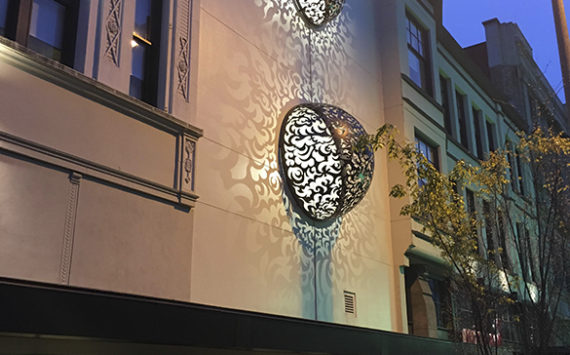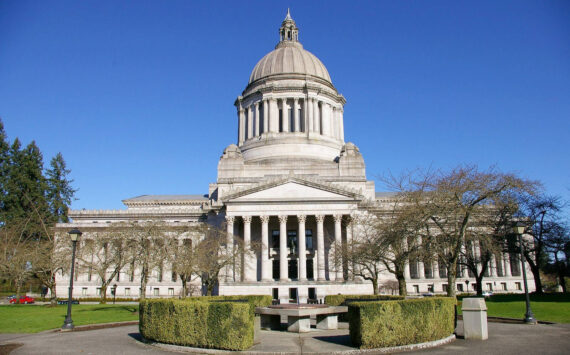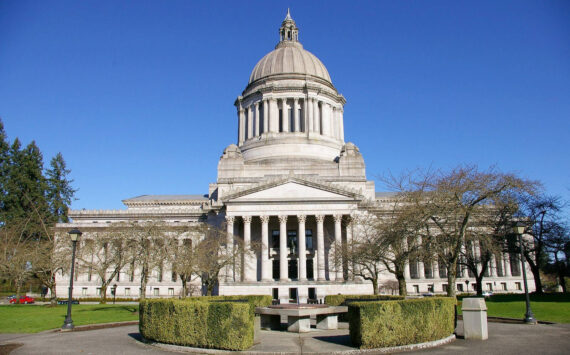A nomination to designate Tacoma’s “Wedge” neighborhood as the city’s next historic district will be reviewed for the second time this month by the City of Tacoma’s Landmarks Preservation Commission.
The commission is expected Wednesday to discuss a schedule for reviewing various elements of the application, as well as a plan to begin providing public notice of meetings related to the nomination. The commission is expected to review the nomination through next spring in a process that will involve the planning commission and include public meetings to review proposed district boundaries, buildings inventory, and the neighborhood’s historic significance.
Members of the Tacoma Wedge Association Historic Subcommittee submitted the nomination on June 27 to the City of Tacoma’s historic preservation office. The group would like to see the area, which stretches from Sixth Avenue to Division Avenue, and L Street to Sprague Avenue — known as the “Wedge” neighborhood — receive historic district designation and special protection against demolition in and around the neighborhood.
The application, which the Index obtained earlier this month, totals several hundred pages, and includes maps, photographs, archival news clippings, and a summary outlining the neighborhood’s historic significance. Among the highlights:
— The Wedge neighborhood includes 67 residential homes built between 1889 and 1928;
— The most unique residential home is the Titlow Mansion, which was built in 1899 and was home to Aaron Titlow, who built Washington State’s first tidewater hotel;
— Homes boast a range of architectural styles, such as Victorian, Craftsman, Foursquare, Dutch Colonial, and Cape Cod;
— The neighborhood was once home to candy company entrepreneurs Frank and Ethel Mars, and Titanic survivor Anne Kincaid.
The neighborhood of quaint homes and tree-lined streets rests against the growing campus of MultiCare Health System, a non-profit network of hospitals and clinics. The nomination is partly aimed at preserving the neighborhood’s character and history in light of a recent demolition of a 90-year-old church, and concern over future demolition and development.
In May 2006, the congregation of First United Methodist Church sold its 1916 church building to MultiCare for $8 million. It was later demolished to make room for the hospital’s expansion. The building was located one block from the Wedge neighborhood’s eastern border, at 423 Martin Luther King Jr. Way.
On Sept. 10, the City’s Landmarks Preservation Commission received its first briefing on the topic by authors of the nomination. The issue of whether Wedge neighbors would battle against MultiCare and its expansion plans was one notable item of discussion.
“I’m sure the hospital has huge influence,” said landmarks preservation commissioner Fred King during the meeting. “They can be a formidable opponent.” King wondered if there was another way to preserve the neighborhood “without getting into a head-on dogfight.”
Commissioner and Wedge resident Ross Buffington responded that the neighborhood has developed a good working relationship with MultiCare in recent years. He added that MultiCare’s expansion plans do not include the proposed historic district — though the company does own four homes within the area. “They have listened to our concerns about parking and houses they currently own,” said Buffington, who has excused himself from voting on the issue because he serves on the landmarks preservation commission and lives in the Wedge neighborhood. “I don’t think it’s all us against them. I appreciate the concern, but I don’t see it as David-versus-Goliath.”
Does the hospital oppose the historic district nomination?
“Not having seen the application and the details of it, I want to reserve an answer for that for now,” says MultiCare spokesperson Todd Kelley. “We can’t really say one way or another.”
Still, the company owns four homes dating back to the late-1880s and early-1990s in the proposed historic district.
“One home is rented out to a family, and three are currently empty,” says Kelley. “Two of them, we’re sort of trying to find a good use for. We don’t have any concrete plans.”
Kelley said he will host a public meeting between MultiCare and Wedge residents Sept. 29 at 6 p.m. at Mary Bridge Hospital, 311 S. L St., in the basement Audio-Visual room to discuss the hospital’s master plan. He will also field questions from people concerned about the four homes MultiCare currently owns within the proposed historic district boundary.
“I’m hoping the meeting on the 29th can open that dialogue in the neighborhood,” says Kelley. “That’s why we’re having that meeting. Not only do we want to show them what we’re thinking about [in terms of the master plan], but we want to hear what they are thinking as well.”
Following the preservation commission meeting Sept. 10, the Index spoke with Char Cooper, Jean Carter, and Laurie Hunger — three Wedge neighborhood residents who authored and submitted the nomination to create a historic district.
TACOMA DAILY INDEX: What was the initial motivation for wanting to designate the Wedge neighborhood historic?
CHAR COOPER: As we started to meet as a group, the conversation went on. There were certain parties that would attend a neighborhood meeting and say, ‘I really want to do this.’ As we talked, wanting to preserve the whole area historically. Once we started that, then it was kind of like we sub-divided into groups and attacked it.
INDEX: When was that?
LAURIE HUNGER: I would say last year, around September.
INDEX: The application is several-hundred pages. How long did it take to put it together?
COOPER: Over a year.
HUNGER: It was a joint effort. We did quite a bit of research down at the Tacoma Public Library. There’s a wonderful wealth of information down there in the Northwest Room.
INDEX: How much of a factor is MultiCare going to be in getting this historic district created?
COOPER: I don’t think they’re going to oppose it. I think they are good neighbors. I think they have so much open land that is not utilized to its fullest right now. We might get push back on the four houses they own [within the proposed district]. I might be naive, but I don’t think we will get the push back that some people are anticipating.
HUNGER: They have really been working hard with us. They solved the problems with traffic.
CARTER: But to answer your question, we don’t know how they are going to feel 25 years from now. They are going to be around, we may not be. They have been involved in a lot of our neighborhood things and listening to concerns. But nobody has been involved in the actual historic development of this application except us.
INDEX: It seems like it’s easy to fall into what one of the landmarks commissioner described as a David vs. Goliath scenario. Do you see it that way?
HUNGER: I don’t think so. They have been really good neighbors. They have really tried to listen to our concerns and really worked with us to try and solve them.
CARTER: But when you bring it up, 25 years from now, who knows?
INDEX: Was MultiCare’s expansion a motivation to create the historic district?
COOPER: I think at one point, when you are looking at our parking issues and the traffic issues and seeing their long-term plans in regards to how they were handling parking, that the parking structures going up are in the future, not more immediate — I think you start to think, OK, someone needs to just be the conscience and say whoa-whoa-whoa and protect ourselves.
INDEX: If I understand it correctly, the last historic district effort was in Old Town in 1999 and it failed. Have you looked into that effort and compared it to your own effort to see how you could make it succeed?
HUNGER: All of our homes in the area, there are two phases — 1880 to 1910; and then the next phase was around 1926. They are all well over the 50-year factor. Most of them are significantly contributing homes in the area. Very few of them — maybe a handful or so — are not.
COOPER: And I think that in [Old Town’s] process, from my understanding, not everybody was aware and onboard as the process was going. I’m feeling pretty comfortable that the majority of residents in our area has at least a broad understanding.
HUNGER: We want to see this happen. We want to work together [with the landmarks commission] to make this happen and get their feedback.
– – – – – – – – – – – – – – – – – – – – – – – –
If you would like to learn more about the Wedge historic district nomination, two meetings will be held to discuss the topic:
— Tacoma’s Landmarks Preservation Commission will discuss the Wedge historic district nomination during its meeting Weds., Sept. 24 at 5 p.m. in the Tacoma Municipal Building North, 728 St. Helens, Room 16. For a copy of the agenda, visit http://www.tacomaculture.org/historic/resources.asp .
— MultiCare will host a public meeting Mon., Sept. 29 at 6 p.m. at Mary Bridge Hospital, 311 S. L St., in the basement Audio-Visual room.
For earlier Index coverage of the Wedge historic district effort, and historic districts in Tacoma, read the following articles:
— Will Tacoma’s Wedge neighborhood go historic? (TDI, 09/05/08) — http://www.tacomadailyindex.com/portals-code/list.cgi?paper=88&cat=23&id=1318920&more=0
— Status Seekers (TDI, 07/03/07) — http://www.tacomadailyindex.com/portals-code/searchd.cgi?paper=88&paper_id=88&keyword=Matthews&skip=0&tbname=storya&tbname1=storya&searchtype=lname&papername=tacoma&year=0&id=354661
